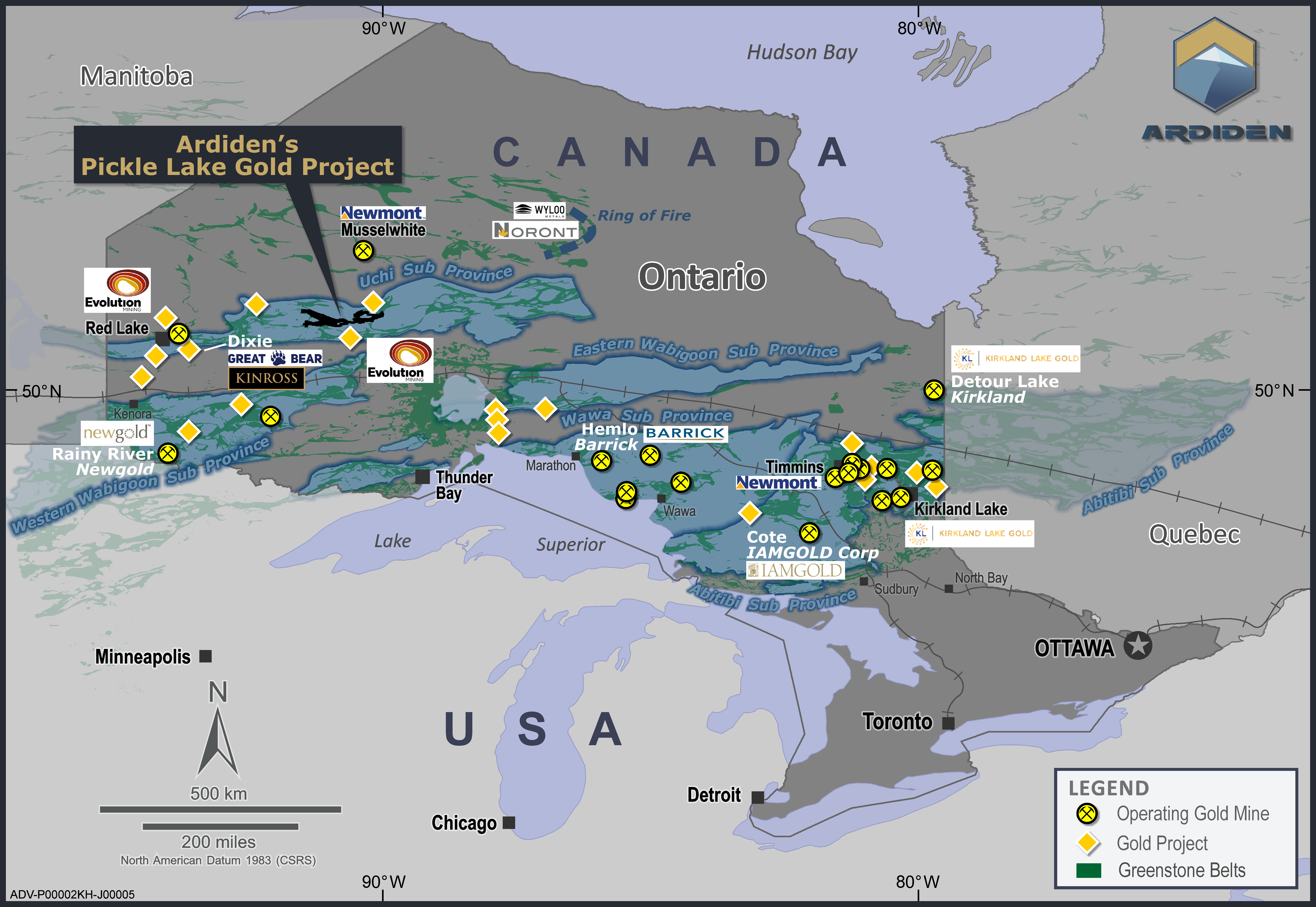Ardiden Ltd’s newly appointed Chair Bruce McFadzean describes the ASX-listed, Canadian-focused, gold junior as operating in “gorilla country” referencing the size and calibre of its neighbours in the gold-rich province of Ontario.
Indeed, Ardiden’s Pickle Lake Gold Project is just down the road from mines operated by the likes of Evolution Mining, Newmont Mining and Barrick Gold.
New mines are also emerging nearby, such as Great Bear Resources’ Dixie discovery, believed to be up to ten million ounces of high-grade resource. The Toronto based Kinross Gold Mining Corporation has just made a bid of C$1.8 billion to acquire Great Bear, which has been diligently working an exploration program since 2018.
Great Bear shares have soared more than fifty-fold in that period, on the back of a drill program and exploration strategy that’s similar to what Ardiden has planned next door at Pickle Lake.
“Ardiden ticks all the boxes of being in the right assets, in the right commodity and the right jurisdiction,” says McFadzean, a 40-year industry veteran who played a key role in the merger of three ASX-listed companies to form Evolution Mining with Jake Klein.
“They’re in gorilla country and have worked diligently to achieve the necessary permitting, so there’s a real opportunity.”
With the ASX ticker ADV, Ardiden is participating in a modern-day gold rush in the highly prospective province.
According to the Ontario Mining Association, there are no fewer than 20 gold producers, with the province accounting for 2.5 million ounces of Canada’s total annual production of six million ounces.
Recent ASX listed arrivals in Ontario include gold focused Evolution and Auteco.
The home to the Toronto Stock Exchange – commonly known as the TSX – mining friendly Ontario is also a key producer of other minerals including nickel, lithium, iron ore, platinum group metals and diamonds.
In another Australian angle, the private, Andrew Forrest backed Wyloo Metals has just prevailed over BHP for control of Canadian nickel explorer Noront Resources and its polymetallic Ring of Fire province, 260 kilometres northwest of Pickle Lake.
Named after the eponymous town on the eastern shore of Pickle Lake, the Pickle Lake zone itself has produced three million ounces since 1935, from four underground operations at a rich average grade of 13 grams per tonne.
Production halted in 1997 – not because of shrinking reserves but due to the prevailing low gold price.
Pickle Lake is within the Uchi (Archean) geological belt, which holds the Red Lake Gold Camp that historically has produced over 30 million ounces. Just north of Pickle Lake, Newmont still operate the Musselwhite gold mine which has produced over three million ounces since mining commenced in 1997.
At Pickle Lake, Ardiden is poised to start an extensive 10,000 metre drilling campaign across its sprawling tenements covering 889 square kilometres. Drilling in 2022 will focus on the Western Hub portion of its Pickle Lake holding, hosting the Dorothy, Dobie, Esker and New Patricia Gold prospects that surround Barrick Gold’s historic Golden Patricia Gold Mine.
To date Ardiden’s activities have centred on its Kasagiminnis (Kas) Deposit, but the broader tenement contains 22 identified target prospects that will be explored systematically.
At Kas, the company has already outlined a maiden JORC-compliant resource of 110,000 ounces: 790,000 tonnes at an impressive 4.3 grams per tonne gold.
Dobie and Dorothy have a historic, non-JORC estimate, of 99,600 ounces (at an average 5.8 g/t). This gives a strong indication of near-surface gold mineralisation that needs ‘stitching together’ in that area of the Western Hub.
Slated to start in January, the winter program on the Western Hub targets 22 prospects. But initially it will focus on the Esker brownfields gold prospect, along strike from Barrick’s Golden Patricia mine that produced 620,000 ounces at an amazing 15.2g/t gold in its heyday.
The program then turns to other brownfields targets, also along strike from Golden Patricia, with geophysics promising to ‘lift the veil’ on other areas of interest.
Ultimately, McFadzean says, the truth will lie at the end of the drill bit.
“There’s a lot of opportunity and a lot of history,” he says. “But you have to drill it to see it, because it’s not at surface.”
Ardiden managing director Rob Longley says the company will take a strategic approach to drilling, rather than chancing its arm with a wildcat approach.
“We already have 110,000 ounces at 4 grams per tonne gold, which shows that when you start drilling you can get a resource at decent grade,” he says.
Central to Ardiden’s success is a close relationship with the local communities, with the company having recently signed a memorandum of understanding with Mishkeegogamang First Nations to proceed with exploration work across the targets.
“If you can’t get ESG [environmental, social and governance] factors right you are not going to operate successfully or efficiently over a long term,” Longley says.
The Perth-based Ardiden has honed its gold focus after demerging its lithium interests – also in Ontario – into Green Technology Metals (ASX code: GT1) in November 2021.
At project level, Ardiden retains a 49 per cent free-carried stake in joint venture with GT1, as well as a 4.9 per cent stake in the lithium and battery metals player itself.
Under the terms of the demerger, GT1 can pick up an additional 29 per cent of the joint venture to achieve 80 per cent ownership, so at worse Ardiden will hold a minimum 20 per cent interest in the project.
“Ardiden is all about being a gold explorer, but we are also getting the value from lithium assets through the work of people more experienced and networked in that industry,” Longley says.
Meanwhile Ardiden bears a lowly market capitalisation of around $24 million including the circa $3.5 million value of the Green Technology stake, which hardly gives justice to the company’s stellar prospects in gorilla country.
With Ardiden’s drill bits whirring, the jungle drums soon should be beating with news of further discoveries in what remains one of the world’s most underexplored gold addresses.














